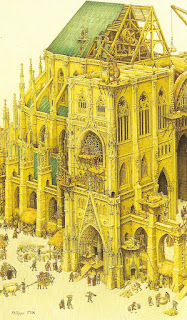 |
| Architect Julia Morgan (1872-1957) around the time she attended the Ecole de Beaux-Arts, and. . . |
And once upon a time, that’s exactly what an architect was--a person whose comprehensive knowledge of construction made him the leader of a building project. It was the architect in the role of master builder, not merely designer, that gave that gave the world the Parthenon, Gothic cathedrals, and countless other creative triumphs.
Even as recently as the 1920s, architects such as Bernard Maybeck and Julia Morgan still spent a considerable amount of time on the construction site. Maybeck, the son of a woodcarver, delighted in working with his hands—he could often be found on his building sites gleefully experimenting with weird and wonderful new methods of construction. Morgan, the architect of William Randolph Hearst’s vast California estate, San Simeon, was the first woman to graduate from the prestigious Ecole de Beaux-Arts in Paris.
 |
| . . .her masterpiece, William Randolph Hearst's Casa Grande at San Simeon, California (begun 1919): "Do it this way, friend." (Photograph by Jake Seiner) |
 |
| Main door to architect Bernard Maybeck's Church of Christ, Scientist, Berkeley (1910). California: He could design the door, and guess what—he could carve it too. Photograph by Justin Zolli. |
There are a few maverick architects today who have tried to mend this estrangement of architects from architecture. Perhaps the best known is Paolo Soleri, whose Arcosanti project in Arizona has for decades struggled to offer architecture students a hands-on education integrating design and construction.
 |
| Paolo Soleri's Arcosanti , north of Phoenix, Arizona, which architecture students have labored on since 1970: An architectural education like no other. (Image courtesy travel2arizona.com} |
 |
| Building a Gothic cathedral: The architect also knew how to build it—something almost unheard of today. |
The problems resulting from this state of affairs are legion. The success of any object, whether a vase, a violin or a building, depends on its designer’s intimate familiarity with the process of its creation. Separate the two, and both are diminished.
Can the architects ever return to their historic role of “archi-tektus”? In the strict sense, perhaps not. A cathedral, for all its aesthetic sophistication, is really just an artfully-arranged pile of stones: it’s well within human comprehension. A modern-day building, however, with its complex structural, mechanical, and electronic systems, is all but beyond the grasp of a single mind.
But that’s not to say that architects can’t learn by doing. Divorcing the design process from the building process, as so many architecture schools continue to do, can only further undermine the historic role of architect as master builder.

No comments:
Post a Comment